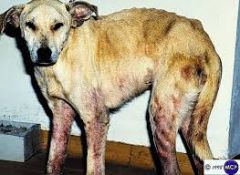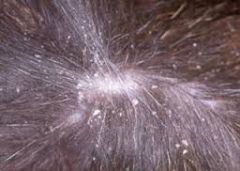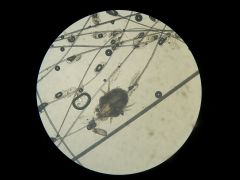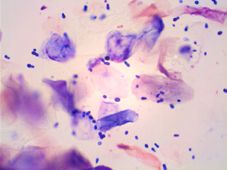![]()
![]()
![]()
Use LEFT and RIGHT arrow keys to navigate between flashcards;
Use UP and DOWN arrow keys to flip the card;
H to show hint;
A reads text to speech;
12 Cards in this Set
- Front
- Back
|
What areas of the an animals body are you most likely to find fleas? |
Tailhead, rump, dorsum, ventral abdomen and flanks. |
|
|
What are fleas a vector for transmitting in dogs and cats? |
Dogs- diphylidum canium Cats- Cat scratch fever. |
|
|
What should we not use as an on the spot treatment in a home with cats and dogs for flea treatment? |
Permethrin products as they are very toxic to cats. |
|

A dog comes into your practice presenting with the following papules, scaling, crusting excoriation and alopecia on the pinna, face, elbows, hocks and ventral chest. Likely cause ? |
Sarcoptes scabei |
|

An owner brings jimmy into your practice who is presented to you because hes constantly itching and its driving his owner bonkers. On examination of Jimmy you notice white dandruff that appears to walk. What is the likely cause of this? |

Cheyletiella |
|
|
Bacterial skin infections are usually secondary to? |
Another disease process. |
|

Malassezia infections of the skin are associated with what in the dog?
|

Maloderous erythema, hyperpigmentation, lichenification, seborrhoea and alopecia. |
|

How do we treat a dog presenting with a secondary Malassezia infection? |
Treatment with chlorhexidine/miconazole shampoo and or topical clotrimazole, miconazole or nystatin. |
|
|
What breeds are susceptible to developing atopic dermatitis? What are underlying causes thought to be? |
Boxers, labradors, GSD, west highland white and other terriers. Allergens such as house mites etc, stress, anxiety, changes in temperature and humidity. |
|
|
Clinical signs of atopic dermatitis? |
No skin lesions, mild to moderate erythema. Usually on muzzle, ventral pinnae, ventral neck, axiallae, abdomen, groin, perineum and feet, flexor joint surfaces. Chronic inflammation with hair loss, excoriation, papules, scaling and crusting, hyperpigmentation and lichenification. Chronic or recurrent otitis externa. Reccurrent staph pyoderma and malassezia dermatitis. |
|
|
What sort of trial can we perform to aid us in diagnosing an allergic skin disease? |
Eliminating other causes of puritus, controlling infection and determining pattern of allergies for each patient. 6-8 week food trial w/ home cooked or commercial, novel, single protein diet. |
|
|
If a food trial doesn't work what can we do to diagnose the source of the allergic skin problem? |
We can do a intradermal skin test or serology. |

